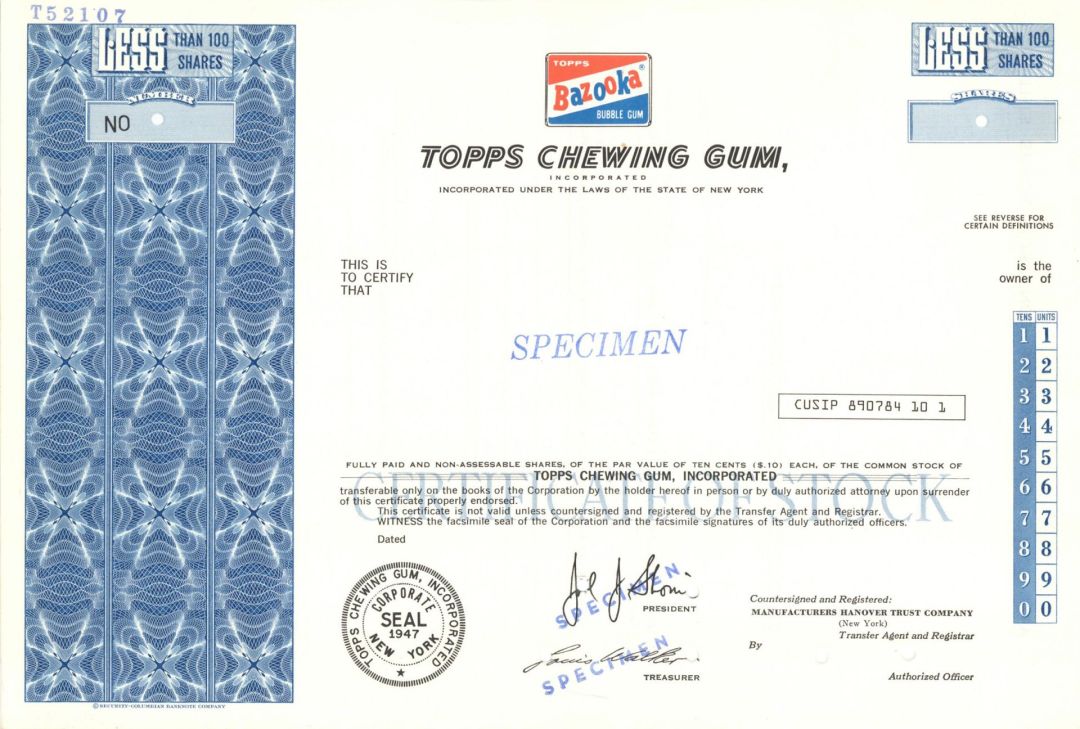Topps Chewing Gum, Inc. - 1947 Specimen Stock Certificate
Inv# SE3824 Specimen StockSpecimen Stock printed by Security-Columbian Banknote Company. Incorporated in 1947.
The Topps Company, Inc. is an American company that manufactures trading cards and other collectibles. Formerly based in New York City, Topps is best known as a leading producer of baseball and other sports and non-sports themed trading cards. Topps also produces cards under the brand names Allen & Ginter and Bowman. In the 2010s, Topps was the only baseball card manufacturer with a license with Major League Baseball. Following the loss of that license to Fanatics, Inc. in 2022, Fanatics acquired Topps in the same year.
Topps itself was founded in 1938, but the company can trace its roots back to an earlier firm, American Leaf Tobacco. Founded in 1890 by members of the Saloman family, the American Leaf Tobacco Co. imported tobacco to the United States and sold it to other tobacco companies. Eventually, in 1908, Morris Chigorinsky Shorin came in control of the company. American Leaf Tobacco encountered difficulties during World War I, as it was cut off from Turkish supplies of tobacco, and later as a result of the Great Depression. Shorin's sons, Abram, Ira, Philip, and Joseph, decided to focus on a new product but take advantage of the company's existing distribution channels. To do this, they relaunched the company as Topps, with the name meant to indicate that it would be "tops" in its field. The chosen field was the manufacture of chewing gum, selected after going into the produce business was considered and rejected. At the time, chewing gum was still a relative novelty sold in individual pieces. Topps's most successful early product was Bazooka bubble gum, which was packaged with a small comic on the wrapper. Starting in 1950, the company decided to try increasing gum sales by packaging them together with trading cards featuring Western character Hopalong Cassidy (William Boyd); at the time Boyd, as one of the biggest stars of early television, was featured in newspaper articles and on magazine covers, along with a significant amount of "Hoppy" merchandising. When Topps next introduced baseball cards as a product, the cards immediately became its primary emphasis. The "father of the modern baseball card" was Sy Berger. In the autumn of 1951, Berger, then a 28-year-old veteran of World War II, designed the 1952 Topps baseball card set with Woody Gelman on the kitchen table of his apartment on Alabama Avenue in Brooklyn. The card design included a player's name, photo, facsimile autograph, team name and logo on the front; and the player's height, weight, bats, throws, birthplace, birthday, stats and a short biography on the back. The basic design is still in use today. Berger would work for Topps for 50 years (1947â97) and serve as a consultant for another five, becoming a well-known figure on the baseball scene, and the face of Topps to major league baseball players, whom he signed up annually and paid in merchandise, like refrigerators and carpeting. The Shorins, in recognition of his negotiation abilities, sent Sy to London in 1964 to negotiate the rights for Topps to produce Beatles trading cards. They also tried hockey. Arriving without an appointment, Sy succeeded by speaking in Yiddish to Brian Epstein, the Beatles' manager. Berger hired a garbage boat to remove leftover boxes of 1952 baseball cards stored in their warehouse, and rode with them as a tugboat pulled them off the New Jersey shore. The cards were then dumped into the Atlantic Ocean. The cards included Mickey Mantle's first Topps card, the most valuable card of the modern era. No one at the time, of course, knew the collector's value the cards would one day attain. On August 28, 2022, the Mickey Mantle baseball card (Topps; #311; SGC MT 9.5) was sold for $12.600 million. Read more at https://en.wikipedia.org/wiki/Topps
Stock and Bond Specimens are made and usually retained by a printer as a record of the contract with a client, generally with manuscript contract notes such as the quantity printed. Specimens are sometimes produced for use by the printing company's sales team as examples of the firms products. These are usually marked "Specimen" and have no serial numbers.










Ebay ID: labarre_galleries